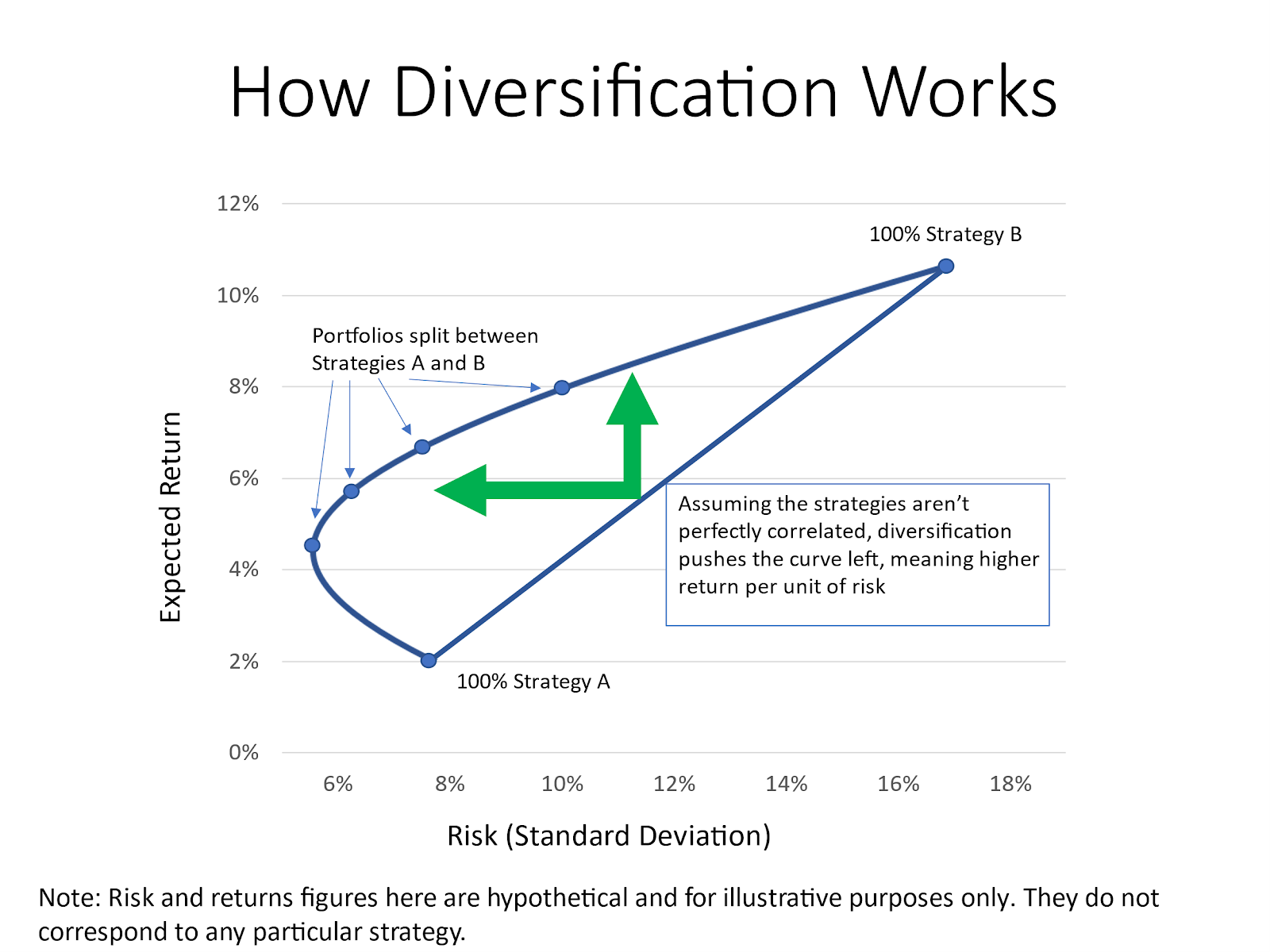How to Manage Portfolio Risk With Diversification
"Don't put all your eggs in one basket" means different things to different investors. Here's how to manage your risk with portfolio diversification.


With the stock market soaring to new all-time highs on what seems like a daily basis, managing your portfolio's risk might not be the first thing on your mind.
If you wait for a downturn, though, it's already too late. You don't want your roof to catch fire before you buy homeowner's insurance.
The best way to manage your portfolio's risk is through proper diversification. And the basic idea is simple enough: Don't put all of your eggs in one basket.
From just $107.88 $24.99 for Kiplinger Personal Finance
Become a smarter, better informed investor. Subscribe from just $107.88 $24.99, plus get up to 4 Special Issues

Sign up for Kiplinger’s Free Newsletters
Profit and prosper with the best of expert advice on investing, taxes, retirement, personal finance and more - straight to your e-mail.
Profit and prosper with the best of expert advice - straight to your e-mail.
But how much diversification is enough? And how do you know if your portfolio is functionally diversified vs apparently diversified?
Your 401(k) account might be spread across 10 different mutual funds. But if they all own substantially the same stocks, you're not diversified. You have the appearance of diversification without the benefits of diversification.
So, let's talk about the basics of diversification and how to ensure your portfolio actually reaps rewards from doing it the right way.
What is diversification?
The core principle of diversification is that prices of different assets move independently of one another and that holding a broad mix of assets reduces your risk.
For instance, when the stock market declines, bonds may increase in value, or real estate might remain stable.
Diversification also works within an asset class. Large-cap tech stocks such as Apple (AAPL) and Microsoft (MSFT) can both be affected by the general direction of the stock market.
But these are also distinct companies with risks and opportunities specific to their respective businesses. Apple might have a great quarter and see its stock soar at the same time Microsoft has a lousy quarter and sees its stock fall, or vice versa.
Perhaps the most important beneficial impact of diversification is a smoothing effect.
Over time, you get the weighted average return of the individual pieces of your portfolio. But, along the way, you suffer less of the up-and-down volatility.
Take a look at the graphic example below. This is for illustrative purposes and does not correspond to any particular strategy.
It shows how diversification increases your return for a given level of risk or lowers your risk for a given level of return.

Strategy A has an expected return of 2% with a risk, or "standard deviation," of 8%. Strategy B has an expected return of 11% with a risk of 16%.
A portfolio split 50-50 between the two will have an expected return of 6.5%, which is the average between 2% and 11%.
But the expected risk won't be the average risk of Strategy A and Strategy B. It will be lower. The straight line gets pushed into a curve.
This is the magic of diversification.
Don't worry if you get lost in the math. The key takeaway is that diversification done right will lower your risk for a given expected return or boost your expected return for a given level of risk.
And the lower the correlation between your assets, the bigger the diversification benefit.
How to check if your portfolio is diversified
So, how do you know if your portfolio is diversified? You can get technical if you're into that sort of thing.
Morningstar, Yahoo Finance, Portfolio Visualizer and a host of other services offer tools that allow you to measure how correlated the assets in your portfolio are and what your portfolio's expected risk and return would be. Your 401(k) provider may offer something similar.
Frankly, folks, you don't need to get all that precise.
In fact, leaning too heavily into the math can give you a false sense of security. Common sense and a couple of basic concepts will likely get you close enough.
One rule of thumb quoted by financial advisers is the "100 minus your age" principle. The idea here is that your allocation to stocks should be roughly equal to 100 minus your age.
If you're 70 years old, you should have about 30% of your money in stocks and the rest in bonds or other safer assets that tend not to move in step with the market.
This is a broad guideline, not an iron-clad law of the universe. Depending on your current wealth, your attitude toward risk and your other sources of income, your ideal number might be higher or lower than that.
You should also diversify within your stock allocation.
As a general rule, you probably don't want more than a couple percent of your portfolio in any single stock. (This rule can bend if you're an aggressive trader, again based on your wealth, your risk tolerance and your objectives.)
An S&P 500 index fund is arguably all the diversification you need, particularly for smaller portfolios. Something like the SPDR S&P 500 ETF Trust (SPY) will give you exposure to a broad swath of America's largest, most dominant companies.
But the S&P 500 isn't the only game in town, and there are stretches of years or even decades at a time when small-cap, mid-cap, real estate and foreign stocks outperform it.
Diversifying with mutual funds or exchange-traded funds that focus on these sectors can potentially reduce your risk and boost your returns over time.
Diversification is a lot like horseshoes and hand grenades: You don't have to hit an exact target.
Close is usually going to be good enough.
Related content
- Kiplinger Interest Rates Outlook: The Fed Pulls Back on Future Rate Cuts
- What Does a Government Shutdown Mean for Stocks?
- How Decentralized Finance Is Reshaping Investment
- Embracing Generative AI for Financial Success
- Five Year-End Strategies You Can't Afford to Miss
Profit and prosper with the best of Kiplinger's advice on investing, taxes, retirement, personal finance and much more. Delivered daily. Enter your email in the box and click Sign Me Up.

Charles Lewis Sizemore, CFA is the Chief Investment Officer of Sizemore Capital Management LLC, a registered investment advisor based in Dallas, Texas, where he specializes in dividend-focused portfolios and in building alternative allocations with minimal correlation to the stock market.
-
 Holiday Tax Scams: 'Tis the Season to be Wary
Holiday Tax Scams: 'Tis the Season to be WaryTax Scams Navigating tax tricks of the holiday season may be daunting, but don't let that destroy your festive spirit
-
 Metro by T-Mobile Is Giving Away This Samsung Galaxy A16: Which Plans Are Eligible?
Metro by T-Mobile Is Giving Away This Samsung Galaxy A16: Which Plans Are Eligible?Metro by T-Mobile is offering free Samsung Galaxy A16 phones on eligible plans right now. Here’s how the deal works.
-
 I Drive and Collect Classic Cars: Here’s How I Got Started
I Drive and Collect Classic Cars: Here’s How I Got StartedAre classic cars a hobby or an investment strategy — or both? Either way, the vintage car scene is much cooler and more affordable than you think.
-
 The $183,000 RMD Shock: Why Roth Conversions in Your 70s Can Be Risky
The $183,000 RMD Shock: Why Roth Conversions in Your 70s Can Be RiskyConverting retirement funds to a Roth is a smart strategy for many, but the older you are, the less time you have to recover the tax bite from the conversion.
-
 A Financial Pro Breaks Retirement Planning Into 5 Manageable Pieces
A Financial Pro Breaks Retirement Planning Into 5 Manageable PiecesThis retirement plan focuses on five key areas — income generation, tax management, asset withdrawals, planning for big expenses and health care, and legacy.
-
 4 Financial To-Dos to Finish 2025 Strong and Start 2026 on Solid Ground
4 Financial To-Dos to Finish 2025 Strong and Start 2026 on Solid GroundDon't overlook these important year-end check-ins. Missed opportunities and avoidable mistakes could end up costing you if you're not paying attention.
-
 Nasdaq Leads as Tech Stages Late-Week Comeback: Stock Market Today
Nasdaq Leads as Tech Stages Late-Week Comeback: Stock Market TodayOracle stock boosted the tech sector on Friday after the company became co-owner of TikTok's U.S. operations.
-
 Are You Putting Yourself Last? The Cost Could Be Your Retirement Security
Are You Putting Yourself Last? The Cost Could Be Your Retirement SecurityIf you're part of the sandwich generation, it's critical that you don't let the needs of your aging parents come at the expense of your future.
-
 I'm an Insurance Pro: It's Time to Prepare for Natural Disasters Like They Could Happen to You
I'm an Insurance Pro: It's Time to Prepare for Natural Disasters Like They Could Happen to YouYou can no longer have the mindset that "that won't happen here." Because it absolutely could. As we head into 2026, consider making a disaster plan.
-
 The Future of Philanthropy Is Female: How Women Will Lead a New Era in Charitable Giving
The Future of Philanthropy Is Female: How Women Will Lead a New Era in Charitable GivingWomen will soon be in charge of trillions in charitable capital, through divorce, inheritance and their own investments. Here's how to use your share for good.
-
 Cooler Inflation Supports a Relief Rally: Stock Market Today
Cooler Inflation Supports a Relief Rally: Stock Market TodayInvestors, traders and speculators welcome much-better-than-hoped-for core CPI data on top of optimism-renewing AI earnings.